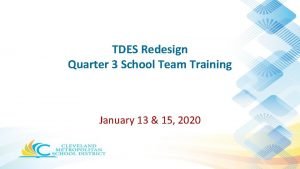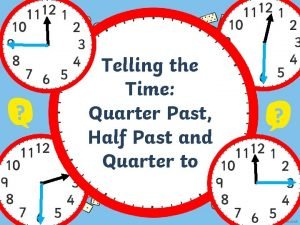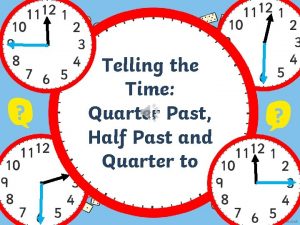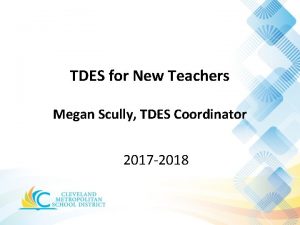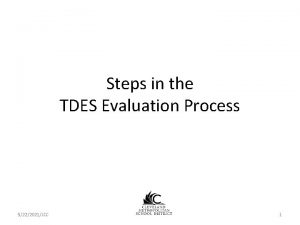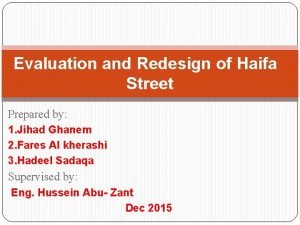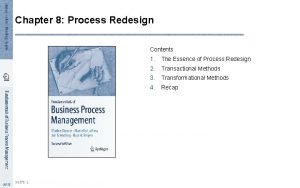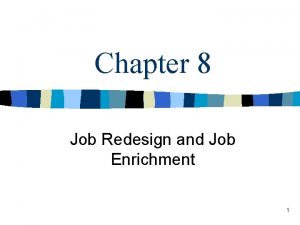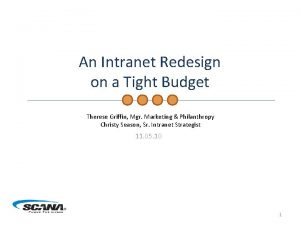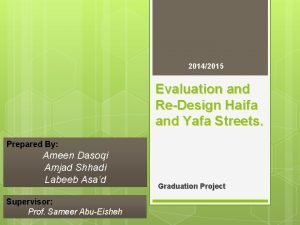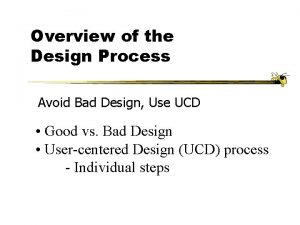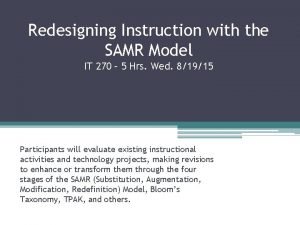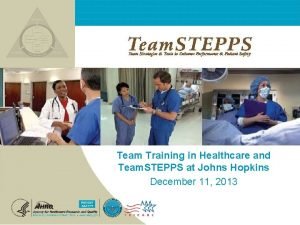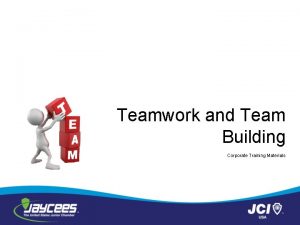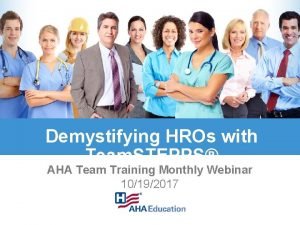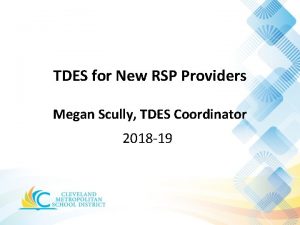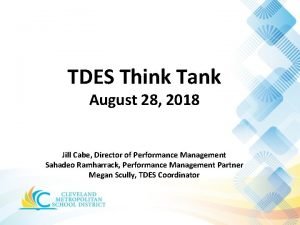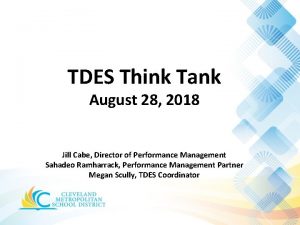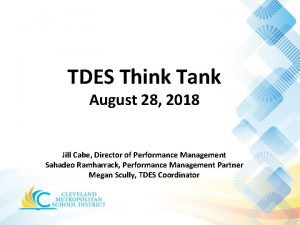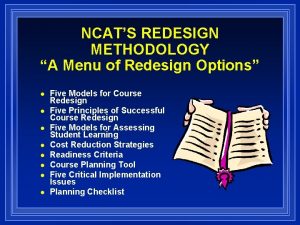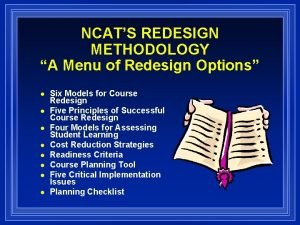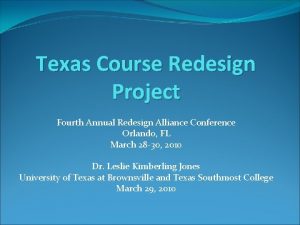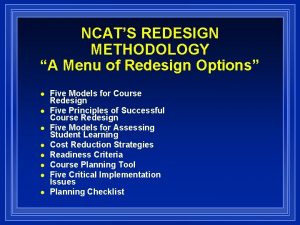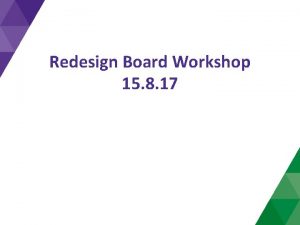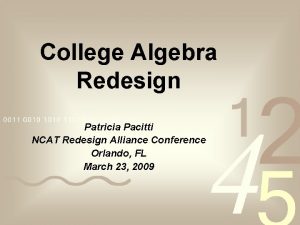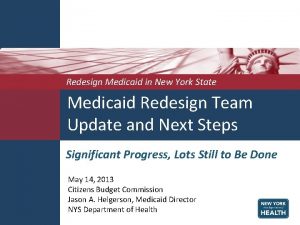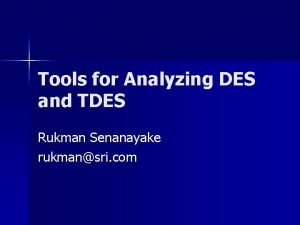TDES Redesign Quarter 1 School Team Training August



























- Slides: 27

TDES Redesign Quarter 1 School Team Training August 26 & 29, 2019

Agenda • Objectives & Introductions • Connection to Prior Learning • PGP – Check In and Conference • TDES Rubric: HQD Changes • FAO Process & Dates • Closing 2

Objectives: Today We Will. . . • Connect to our prior learning in the July Training • Compare and contrast the responsibilities of the evaluator and the professional with the PGP & IP • Understand the high quality data changes to the Rubric • Identify the procedures for an FAO • Clarity for implementation 3

Norms D Start on time, end on time Low tech, high engagement Embrace AND provide feedback Assume the best Professional pride Cleaner than we found it 4

School Team Roles Activity: In 30 seconds or less, identify the following present team members for active roles to support our learning. Depending on your group size, you may have more than one role. ü Facilitator ü Timekeeper ü Recorder ü Presenter ü Process Observer ü Group Member on Deck ü Resource Officer 5

Connection to Prior Learning Activity: In your school teams, have a facilitated group discussion in four minutes about the following probing questions: § What were your specific learning take aways from your July training? § What went well in your school training? Why? § What could have been improved in your school training? Why? § What knowledge gaps does your school staff still have? 6

Compare and Contrast Activity: In your school team, compare and contrast the roles of the evaluator and the professional in the Growth Plan and Improvement Plan process. How are the roles different or similar? Be sure to keep in mind the new language in your Guidebook. Be prepared to report out. (7 minutes) Report Out 7

Growth Plans and Improvement Plans Professional Growth Plans Professional Improvement Plans Two goals: one goal based on a TDES component and one goal based on an element from the standards (the link for professional standards is listed on the TDES website) Evaluator will work with the professional to set at least two no more than three goals based on a TDES component and one element from the standards. Review the previous year’s progress when determining goals and plan to achieve goals. Guide professional’s work for the year Discussed at post-conferences Assessed at the end of the year Review value-added data, if applicable 8

Overview of Changes to Growth Plans During Off Years Accomplished Skilled Develop a self-directed professional growth plan Jointly develop a professional growth plan One check-in visit Conference 9

Overview of Growth Plan Check-In • Professional and evaluator schedule the check-in. • Evaluator visits classroom for up to 30 minutes to observe practice. • Evaluator may use the Growth Plan Check-In Form to document that the Check-In occurred • No evidence is uploaded to the TDES Portal • What if there are two off-stage goals? 10

Professional Growth Plan (PGP) Check-In Form • Note if the PGP is Self-Directed or Collaborative • Goal Statements and Evidence Indicators are taken directly from the Professional Growth Plan in the portal. • Dates – note the date of the check-in and conference • Areas for Professional Growth – add supports or resources that can assist • The check-in form is only to be used to document that the check-in occurred and is not uploaded into the TDES Portal 11

Overview of Growth Plan Conference • Professional and evaluator schedule the PGP Conference. • The conference should be scheduled within 10 working days of the check-in. • Professional and Evaluator meet for up to 20 minutes. • Evaluator focuses on providing feedback on the goals identified in the growth plan. • Evaluator notes in the TDES portal the professional’s progress at the conference. This is under the Growth Plan Tab. • Progress towards professional goals is intended to be developmental for the professional, and is not to be used for discipline. 12

PGP & IP Due Dates and Check in Form PGP/IP Due: September 13, Year Round September 27, Traditional & RSP PGP Check in: Quarter 2 (October 14 -December 20) or Quarter 3 (January 7 -March 6) PGP Conference: Quarter 2 or 3 (see dates above) 13

14

Component Ineffective Developing Skilled Accomplished 1 b: Demonstrating knowledge of students Teacher demonstrates little or no knowledge of students’ backgrounds, cultures, skills, language proficiency, interests, and special needs, and does not seek such understanding. Teacher does not draw upon sources of high-quality student data. Teacher indicates the importance of understanding students’ backgrounds, cultures, skills, language proficiency, interests, and special needs, and attains this knowledge for the class as a whole, using one method of information -gathering. Teacher draws upon an analysis of a single source of high-quality student data. Teacher actively seeks knowledge of students’ knowledge of backgrounds, cultures, students’ skills, language backgrounds, proficiency, interests, cultures, skills, and special needs, and language proficiency, attains this knowledge interests, and special for groups of students. needs from a variety Teacher draws upon an of sources, and attains accurate analysis on this knowledge for multiple sources of high individual students. -quality student data for Teacher draws upon groups of students. an accurate analysis of purposefully chosen and appropriate sources of high-quality student data for individual students. 15

Each envelope contains several sources of high quality student data. Take an inventory of what data sources you have and what general information each provides. Share out at your table. 16

Choose 2 sources of data that you could use as evidence for demonstrating knowledge of your students. Analyze the information provided. What does it tell you about your class? Groups of students? Individual students? For the artifacts that do not have example data included, you can create a scenario of what your class results might look like and explain how you might use that data. How do the results affect classroom decisions? Discuss how this evidence is captured in the portal. 17

Formal Announced Observations 18

Formal Announced Observation (1 of 2) 1. Evaluator and professional collaboratively agree upon the FAO dates for the observation, pre-and post-conferences 2. Professional submits lesson plan through the portal prior to the pre-conference 3. Professional and evaluator hold a pre-conference to discuss the lesson plan 4. Evaluator observes lesson for at least 30 minutes 5. Evaluator submits evidence within 24 hours of the event; professional can submit evidence within 24 -48 hours after receiving evaluator evidence.

Formal Announced Observation (2 of 2) 6. When adding evidence, both the evaluator and professional should clearly label any attachments with a specific component 7. Professional self-assesses on the rubric 8. Evaluator marks areas of agreement on the rubric and shares with the professional. 9. Professional and evaluator meet for the post- conference to discuss areas not agreed upon and complete the rubric All must occur within 10 working days from pre-conference to postconference.

Formal Announced Observation • If the FAO does not occur when scheduled, the originally submitted TDES lesson plan and evidence in the portal will be used for Domain 1 evidence. A mutually agreed upon date and time will be rescheduled for the observation and postconference to capture Domain 2, 3, and 4 evidence. • If a teacher is rated Ineffective, they will have a walkthrough prior to their FAO. 21

Formal Announced Observation Timelines • The complete FAO process (pre-conference, FAO, and post-conference) need to be completed within 10 days • All Formal Announced Observations need to be completed prior to December 13. • Build a schedule with collaboratively agreed upon dates to insure completion prior to the deadline 22

Appeals • A professional can file an appeal on their FAO within ten (10) working days of the post-conference. • The appeal is emailed to the Network Leader. Please be specific. Note any procedural errors and/or what components you are asking to be reviewed. • The Network Leader has ten (10) working days to respond. • If not resolved, the professional can forward the appeal to the TDES Co. Chairs at TDES@clevelandmetroschools. org • The TDES Co-Chairs have ten (10) working days to respond. 23

FAO True or False Sample Statement 1. The FAO pre-conference, observation, and post-conference need to occur within 10 working days 2. The evaluator can determine the date and time of the FAO Observation True or False True False 3. The professional completes the TDES Lesson Plan in the portal before the pre-conference. True 4. The professional has ten (10) days from the post-conference to file an appeal True 5. The professional self-assesses on the rubric at the post-conference. 6. The evaluator marks areas of agreement on the rubric prior to the post-conference. 7. The professional can upload evidence into the portal a week after they receive evidence from the evaluator False True False 24

Questions

TDES Redesign FAQs • Do Accomplished teachers write a growth plan? • Is Walkthrough 1 required for everyone before the FAO? • Do limited contract teachers rated Skilled or Accomplished in 18 -19 need to be evaluated this year? • Do teachers applying for their continuing contract this year need to be evaluated? • Are teachers who defaulted to Skilled in an off-year? • Are more than 2 data sources required to receive an Accomplished rating in a component? • Do Art teachers need to upload student learning data for ALL of their students to be rated Skilled or Accomplished in a component? • Are new teachers required to attend 6 hours of training outside of their building? • Are all paraprofessionals being evaluated this year? • How do I know who in my building needs evaluated? 26

 Tdes school
Tdes school Quarter half an hour
Quarter half an hour Quarter past 6
Quarter past 6 Tdes rubric
Tdes rubric Tdes rubric
Tdes rubric Tdes growth plan
Tdes growth plan Getting organizational redesign right
Getting organizational redesign right Bh redesign
Bh redesign Job redesign meaning
Job redesign meaning Procurement process redesign
Procurement process redesign Redesign haifa
Redesign haifa The redesign orbit
The redesign orbit Job redesign meaning
Job redesign meaning Design and redesign of work systems
Design and redesign of work systems Principles of business process reengineering
Principles of business process reengineering Scina
Scina Redesign haifa
Redesign haifa Redesign bad honnef
Redesign bad honnef Iu hr job framework
Iu hr job framework Intranet redesign project plan
Intranet redesign project plan Technology allows for significant task redesign
Technology allows for significant task redesign Radical redesign of business processes
Radical redesign of business processes Bureaucratic bypass syndrome
Bureaucratic bypass syndrome Team spirit becomes team infatuation
Team spirit becomes team infatuation The white team cheers for the blue team, just like
The white team cheers for the blue team, just like Stepps framework
Stepps framework Teamwork training material
Teamwork training material Brief huddle debrief
Brief huddle debrief
